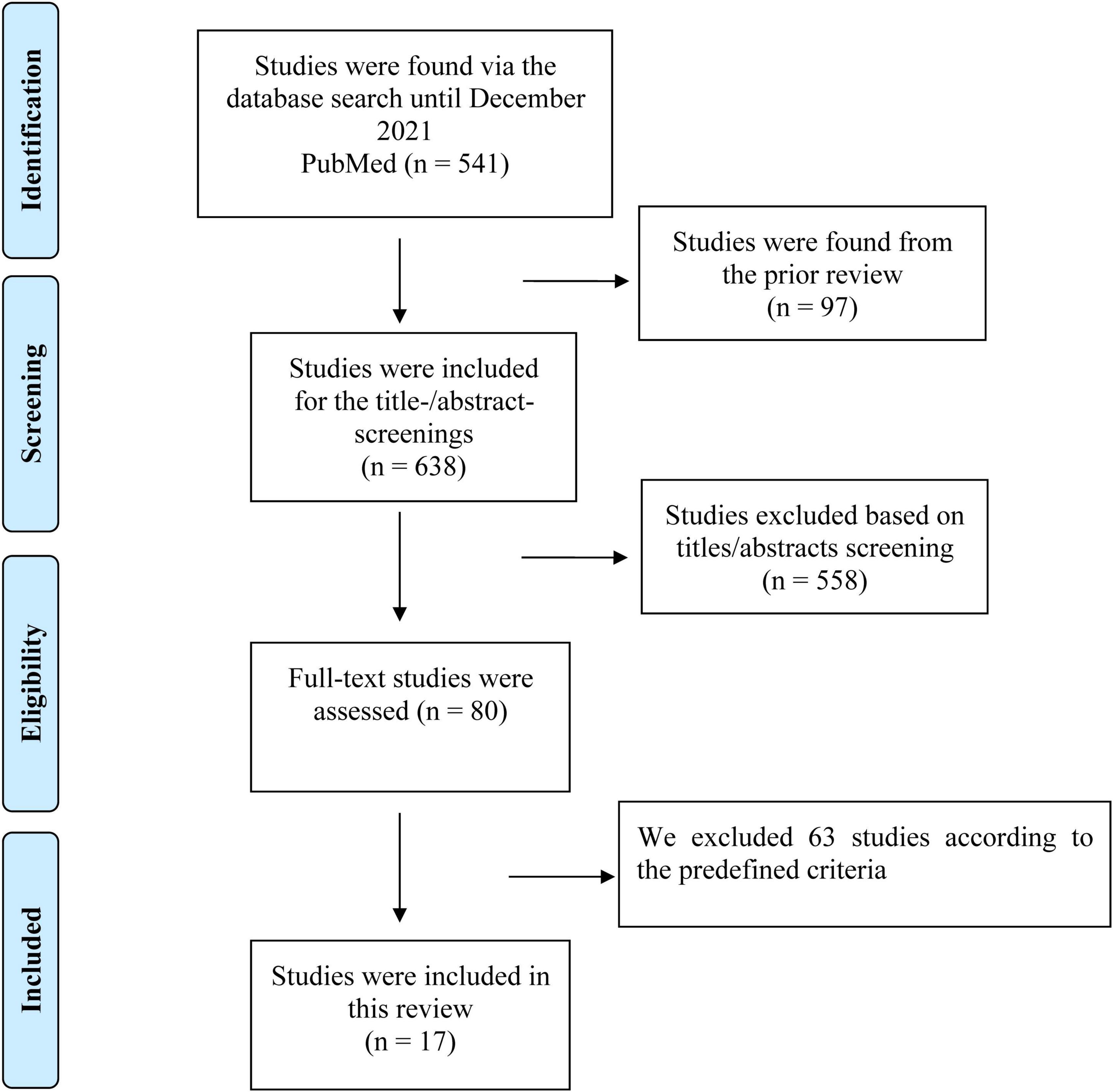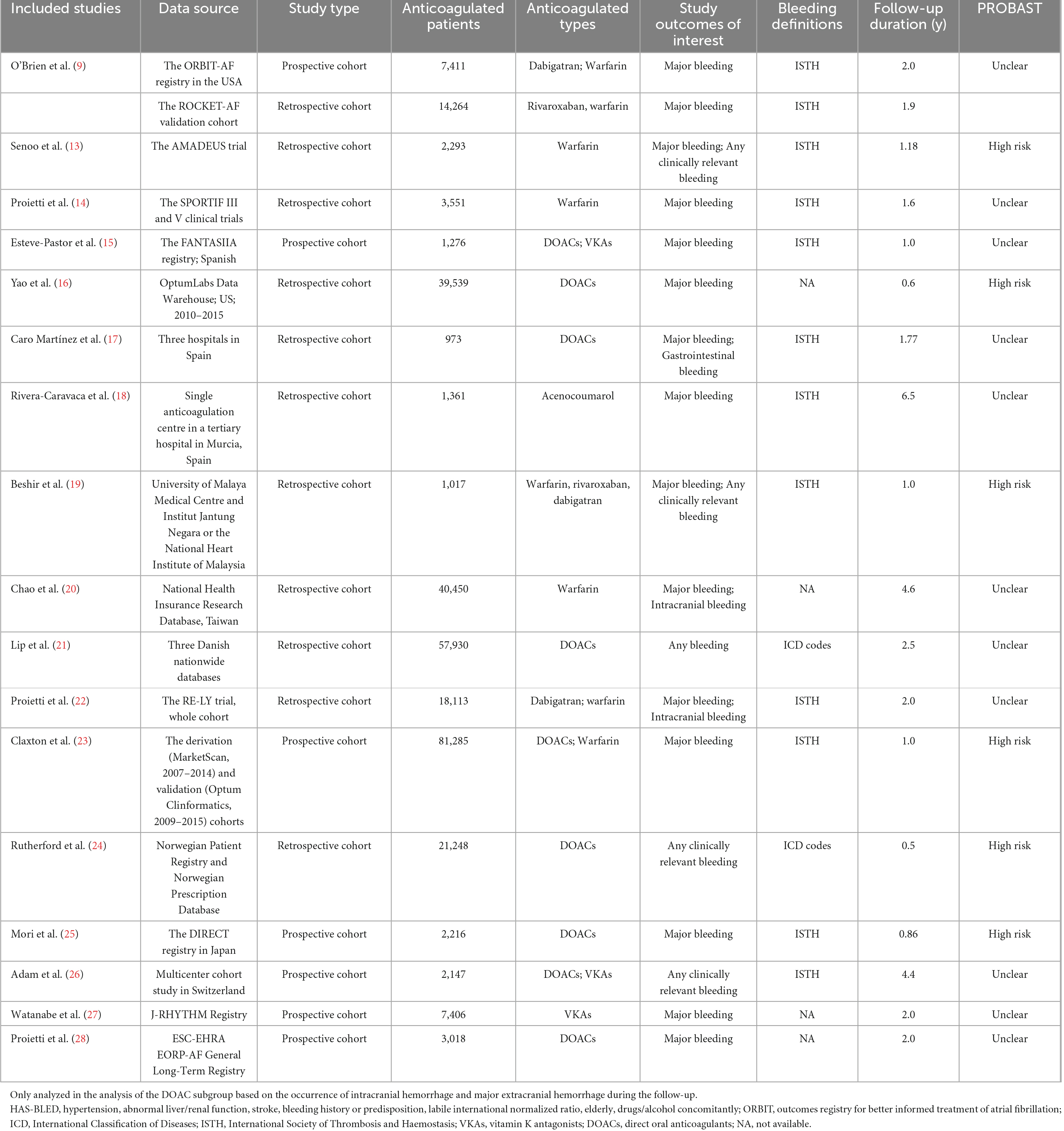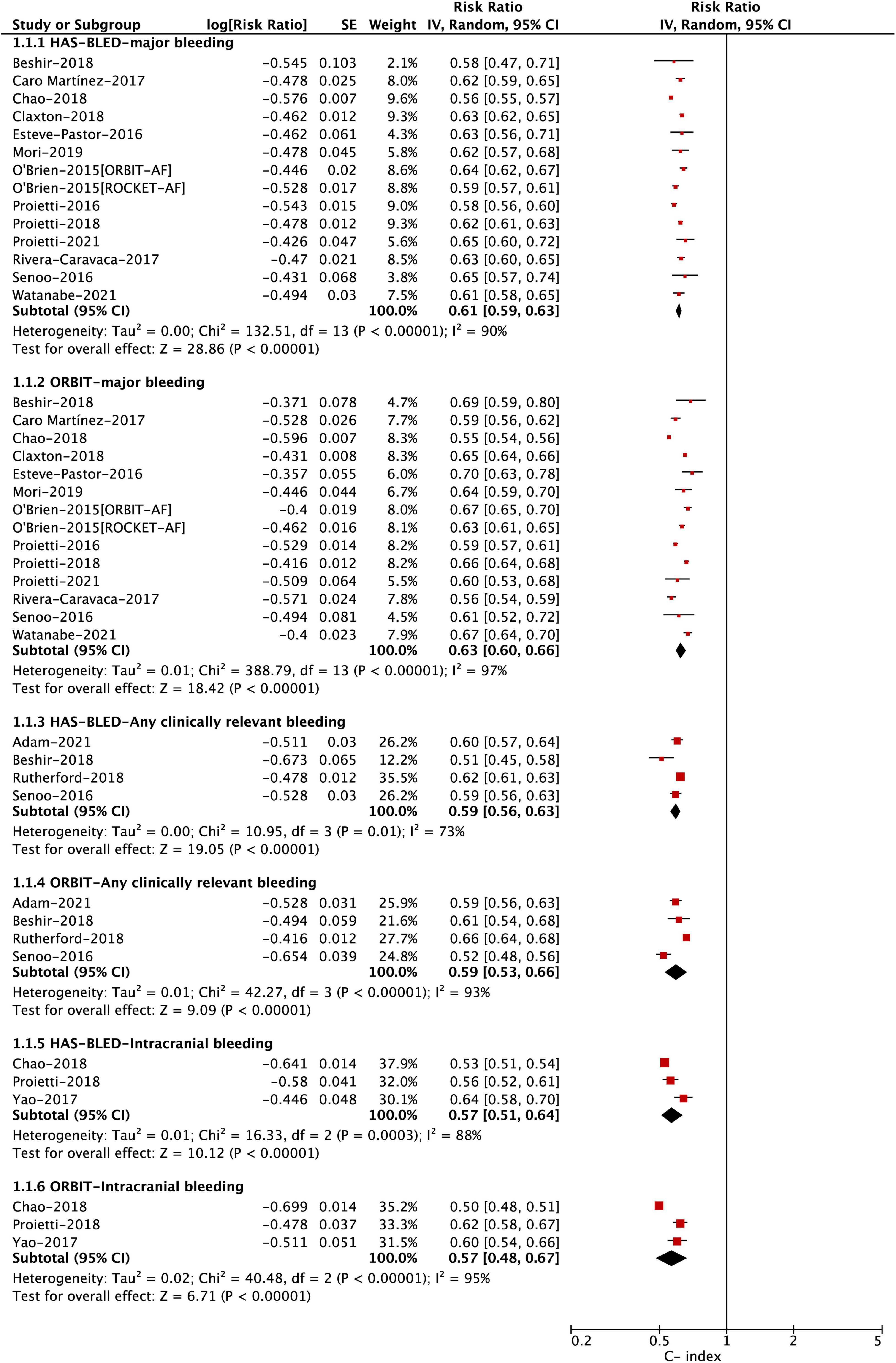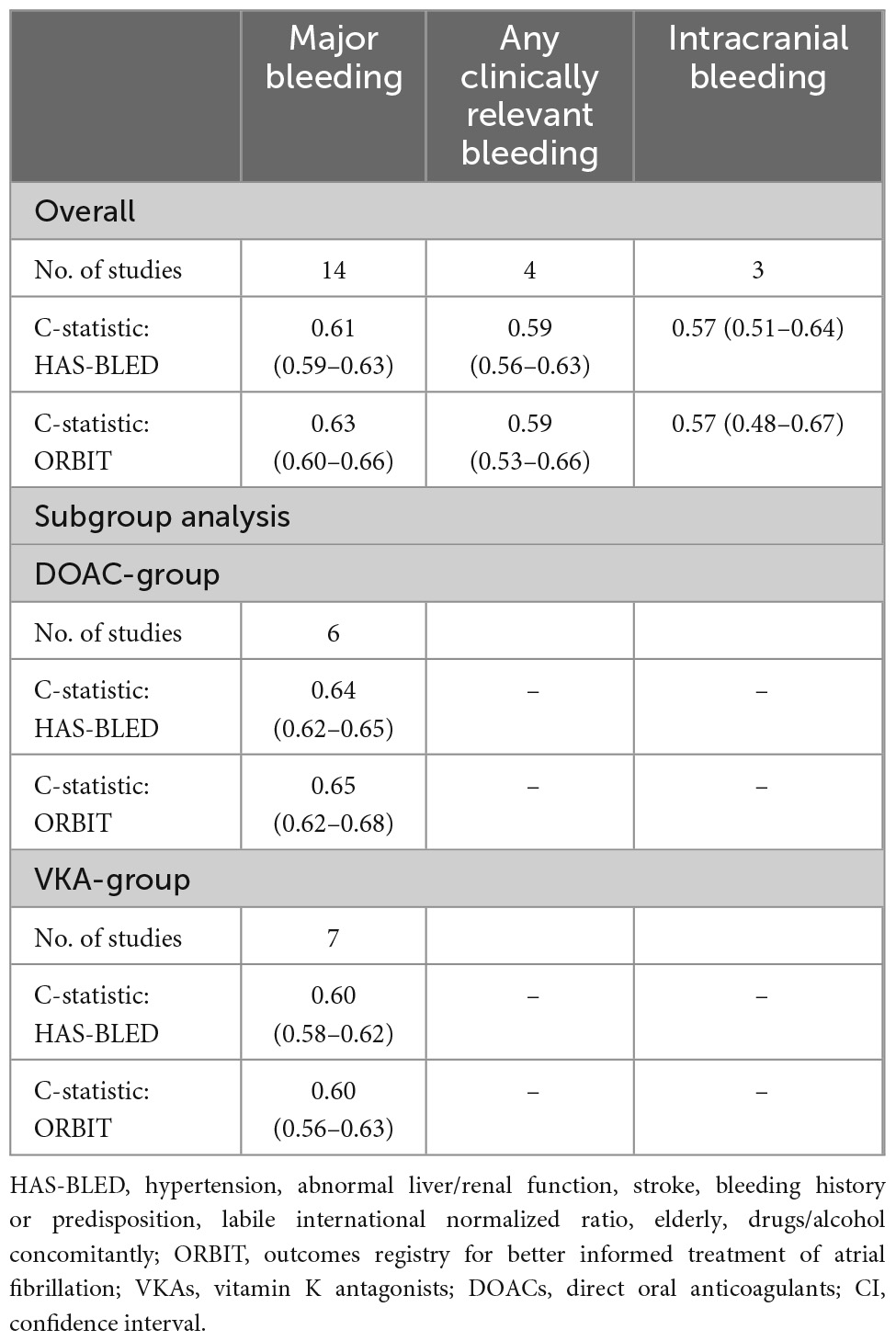- 1Department of Cardiology, Affiliated Hospital of Jinggangshan University, Jinggangshan University, Ji’an, Jiangxi, China
- 2Department of Medical Genetics, The Second Affiliated Hospital of Nanchang University, Nanchang, Jiangxi, China
- 3Department of Cardiology, Jiangxi Provincial People’s Hospital Affiliated to Nanchang University, Nanchang, Jiangxi, China
Background: The 2021 UK National Institute for Health and Care Excellence guidelines tend to recommend the ORBIT score for predicting bleeding risk in patients with atrial fibrillation (AF) with anticoagulants. Herein, we comprehensively re-assessed the predicted abilities of the HAS-BLED vs. ORBIT score since several newly published data showed different findings.
Methods: We comprehensively searched the PubMed electronic database until December 2021 to identify relevant studies reporting the ORBIT vs. HAS-BLED scores in anticoagulated patients with AF. Their predicted abilities were assessed using the C-index, reclassification, and calibration analysis.
Results: Finally, 17 studies were included in this review. In the pooled analysis, the ORBIT score had a C-index of 0.63 (0.60–0.66), 0.59 (0.53–0.66), and 0.57 (0.48–0.67) for major bleeding, any clinically relevant bleeding, and intracranial bleeding, respectively, while the HAS-BLED score had a C-index of 0.61 (0.59–0.63), 0.59 (0.56–0.63), and 0.57 (0.51–0.64) for major bleeding, any clinically relevant bleeding, and intracranial bleeding, respectively. There were no statistical differences in the accuracy of predicting these bleeding events between the two scoring systems. For the outcome of major bleeding, the subgroup analyses based on vitamin K antagonists vs. direct oral anticoagulants suggested no differences in the discrimination ability between the HAS-BLED and ORBIT scores. Reclassification and calibration analyses of HAS-BLED vs. ORBIT should be further assessed due to the limited and conflicting data.
Conclusion: Our current findings suggested that the HAS-BLED and ORBIT scores at least had similar predictive abilities for major bleeding risk in anticoagulated (vitamin K antagonists or direct oral anticoagulants) patients with AF, supporting the use of the HAS-BLED score in clinical practice.
Introduction
Atrial fibrillation (AF) is the most common cardiac arrhythmia, the leading cause of cardiovascular diseases and death worldwide (1). Generally, the most worrisome complication of AF is cardiac stroke. Effective stroke prevention requires the use of oral anticoagulants, including vitamin K antagonists (VKAs) or direct oral anticoagulants (DOACs) (2). However, bleeding events will occur after receiving anticoagulation therapy, and it is very important to accurately assess the risk of embolism and bleeding in clinical practice. Over the past few decades, various bleeding risk scores have been proposed (3–5). Among these proposed bleeding risk scores, the HAS-BLED score (hypertension [H, 1 point], abnormal liver/renal function [A, 1 point each], stroke [S, 1 point], bleeding history or predisposition [B, 1 point], labile international normalized ratio [L, 1 point], elderly [E, 1 point], and drugs/alcohol concomitantly [D, 1 point each]) have become increasingly popular in the clinical settings (6, 7). Patients with HAS-BLED < 3 are divided into the low-risk group, while those with HAS-BLED ≥ 3 are divided into the high-risk group (2, 8).
In 2015, O’Brien et al. (9) derived and validated another bleeding risk score, ORBIT, which consists of 1 point for age ≥ 75 years, 2 points for reduced hemoglobin/hematocrit/history of anemia, 2 points for bleeding history, and 1 point for impaired renal function (<60 mL/min/1.73 m2). The previous meta-analysis comparing the HAS-BLED score with the ORBIT score showed that the HAS-BLED score was no better than the ORBIT score in predicting major bleeding events in anticoagulated patients with AF (10). However, this meta-analysis (10) did not compare the predictive power of the ORBIT and HAS-BLED scores for bleeding risk in different oral anticoagulant use statuses. Given recently updated research comparing the ORBIT and HAS-BLED scores, whether the ORBIT or HAS-BLED score has better predictive power for bleeding in patients with AF remains controversial. In addition, the 2021 UK National Institute for Health and Care Excellence guidelines tend to recommend the ORBIT score for predicting bleeding risk in patients with AF with anticoagulants (11). Therefore, we performed a systematic review and meta-analysis aiming to re-assess the diagnostic accuracy of the HAS-BLED vs. ORBIT scores for predicting bleeding risks in anticoagulated (VKAs or DOACs) patients with AF.
Methods
Literature search
We comprehensively searched the PubMed electronic database until December 2021 to identify relevant literature reporting the ORBIT vs. HAS-BLED scores in anticoagulated patients with AF. The following keywords in the search strategies were used: (1) atrial fibrillation AND (2) vitamin K antagonists OR warfarin OR coumadin OR phenprocoumon OR acenocoumarol OR indandione OR fluindione OR phenindione OR anisindione OR non-vitamin K antagonists OR direct oral anticoagulants OR dabigatran OR rivaroxaban OR apixaban OR edoxaban AND (3) HAS-BLED. We did not search “ORBIT” in this study. In addition, we checked previous reviews for additional studies (4, 5, 10, 12). Studies published in English were included in this study.
Eligibility criteria
We included the studies if they met the inclusion criteria: (1) adult non-valvular patients with AF treated with VKAs or DOACs; (2) studies reported the diagnostic performance of the ORBIT vs. HAS-BLED scores; (c) major bleeding and any other bleeding events, such as any clinically relevant bleeding, any bleeding, intracranial bleeding, and gastrointestinal bleeding; (d) at least one of the following data were reported: C-index, net reclassification improvement (NRI) and integrated discrimination improvement [IDI] values, and calibration data. We excluded studies with insufficient data, such as reviews, case reports, comments, editorials, letters, or abstracts.
Study selection and data extraction
Two authors independently assessed the relevant studies based on the predetermined criteria. We included the qualified articles after the title/abstract screenings and the full-text screenings. Disagreements were resolved through discussion or consultation with a third reviewer. Data were abstracted from the included studies. We abstracted the following data: author, year of publication, study type, data source, baseline patient characteristics (age, sex ratio, sample size, and type of anticoagulants), study outcomes, and follow-up time.
Quality assessment
The quality assessment was performed using the prediction model risk of bias assessment tool (PROBAST),1 consisting of four domains including participants, predictors, outcomes, and analysis.
Statistical analyses
The consistency of the included studies was assessed through the Cochrane Q-test and I2 index. Significant heterogeneity was considered if the P-value of the Cochrane Q-test < 0.1 or if the I2 value of >50%. In the discrimination analysis, the C-index and 95% confidence interval (CI) were abstracted from each included study and pooled by a random-effects model with an inverse variance method. The Z-statistic was calculated to compare the two C-indexes of the ORBIT vs. HAS-BLED models (10). For the primary major bleeding events, the subgroup analyses were conducted on the basis of VKAs vs. DOACs or available vs. unavailable labile INRs (Supplementary Table 1). We used the funnel plots to examine the publication bias, and visual inspection of asymmetry indicated a bias. In addition, we performed narrative analyses on the improvement in predictive accuracy by the reclassification analysis, including the NRI and IDI values. Calibration data represented the extent to which predicted risks correspond to observed risks.
All the statistical analyses were carried out using the Review Manager 5.4 software. A P-value of <0.05 indicated statistical significance.
Results
The flowchart of the document retrieval and screening process is shown in Figure 1. We initially retrieved 541 studies through an electronic search of the PubMed database. We also found additional 97 studies from the prior reviews. After the screenings of the titles and abstracts, 80 studies were assessed in full-texts, and 63 of these studies were excluded according to the predefined criteria. Finally, a total of 17 studies were included in this meta-analysis (9, 13–28).
Table 1 shows the baseline characteristics of the 17 studies included in this review. The quality assessment by the PROBAST is shown in Supplementary Table 2, suggesting that all of the included studies had a high or unclear risk of biases.
Discrimination analysis between HAS-BLED and ORBIT
The discrimination analysis was assessed by the C-index between the HAS-BLED and ORBIT scores. In the pooled analysis shown in Figure 2 and Table 2, the ORBIT score had a C-index of 0.63 (0.60–0.66), 0.59 (0.53–0.66), and 0.57 (0.48–0.67) for major bleeding, any clinically relevant bleeding, and intracranial bleeding, respectively. Similarly, the HAS-BLED score had a C-index of 0.61 (0.59–0.63), 0.59 (0.56–0.63), and 0.57 (0.51–0.64) for major bleeding, any clinically relevant bleeding, and intracranial bleeding, respectively. The Z-statistics suggested that the two scoring systems had no statistical differences in the accuracy of predicting bleeding events (major bleeding, any clinically relevant bleeding, and intracranial bleeding) after anticoagulation in patients with AF. For the outcome of major bleeding, the subgroup analyses based on the OAC type suggested that there were no differences in the discrimination ability between the HAS-BLED and ORBIT scores in either the DOAC or VKA group (Figure 3 and Table 2). In addition, the subgroup analyses based on available vs. unavailable labile INRs also showed no difference.
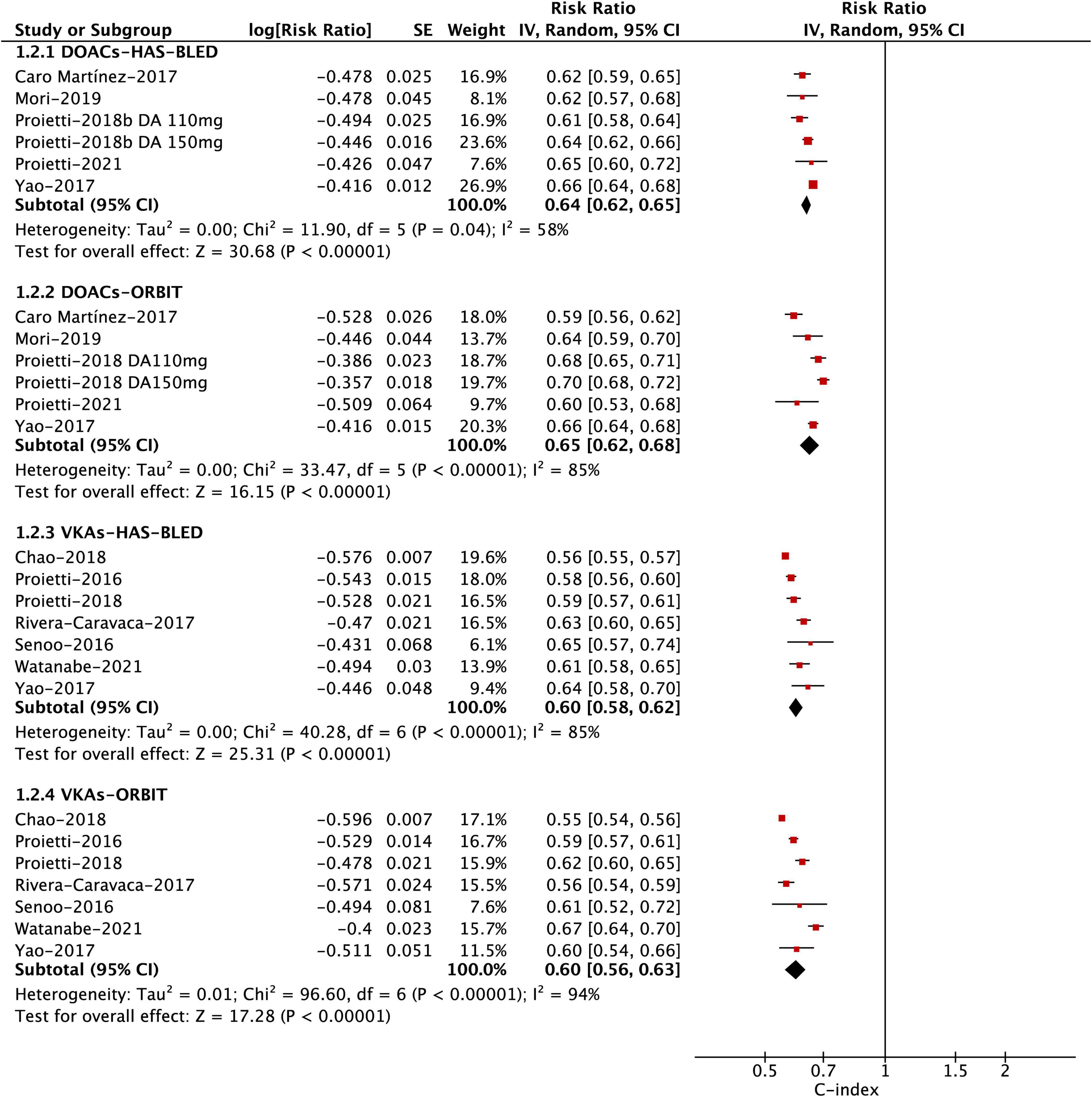
Figure 3. Pooled analysis of the C-statistics of different subgroups by using DOAC or VKA for major bleeding.
Reclassification analysis between HAS-BLED and ORBIT
The NRI and IDI data between the HAS-BLED and ORBIT scores are presented in Supplementary Table 3. For the primary outcome of major bleeding, only four included studies reported the NRI and IDI values between the two studied risk scores. Consistently, the HAS-BLED score in these four studies showed positive NRI and IDI values compared with the ORBIT score, although not significant in each included study. In addition, for the outcome of intracranial bleeding, Chao et al. reported that the HAS-BLED score had a significantly positive NRI value (+4.8%, P < 0.001) compared with the ORBIT score. No NRI and IDI data were reported about any other bleeding outcomes.
Calibration analysis between HAS-BLED and ORBIT
Calibration data between the HAS-BLED and ORBIT scores from seven included studies are displayed in Supplementary Table 4. However, we found that their findings of this part were not consistent among the included studies. Proietti et al., Lip et al., O’Brien et al., and Watanabe et al. showed that ORBIT had a better calibration than HAS-BLED, while Proietti et al. acquired the opposite finding. Beshir et al. and Mori et al. found no difference in the calibration data between ORBIT and HAS-BLED.
Publication bias
As shown in Supplementary Figure 1, when analyzing the C-index, we found no potential publication biases when inspecting the funnel plot.
Discussion
The goal of anticoagulation in patients with AF is to minimize the occurrence of adverse events (especially the risk of stroke) by preventing thrombosis, while the risk of bleeding is significantly increased during anticoagulation. Therefore, the accurate prediction of patients with AF with a high bleeding risk is helpful. To date, multiple bleeding risk scores have been created for the assessment of bleeding risk in patients with AF on anticoagulation (29). Moreover, the HAS-BLED and ORBIT scores have been validated in different populations, especially patients with AF using DOACs. These two scores, especially the HAS-BLED score, are currently the most commonly used score in trials and clinical practice systems. Therefore, this study mainly conducted a meta-analysis on the predictive power of the ORBIT vs. HAS-BLED scores in patients with AF with different anticoagulants (VKAs or DOACs).
Our results showed that ORBIT was comparable to the HAS-BLED score in predicting major bleeding, any clinically relevant bleeding, and intracranial hemorrhage in patients with AF treated with anticoagulation. However, the HAS-BLED score was found to be more predictive than the ORBIT score in terms of NRI and IDI values. Because the criterion of “unstable INR” is difficult to be defined and detected, the HAS-BLED score is less suitable for patients with AF who have received anticoagulation therapy with DOACs or have not received anticoagulation therapy. By contrast, the ORBIT score no longer includes “unstable INR.” Subsequent studies comparing the ORBIT with the HAS-BLED score showed greater variability in the predictive values (13, 16, 28, 30). Some cohort studies showed that the HAS-BLED was superior to the ORBIT score in predicting bleeding risk in patients with VKAs or DOACs (28), potentially consistent with our current findings. While in patients with AF receiving VKAs, the ORBIT score was less predictive in ultimately identifying patients with truly “low risk” of major bleeding but was ultimately in identifying truly “low risk” major bleeding in patients with AF receiving VKA anticoagulation. The exclusion of unstable INR or alternative assessment of anticoagulation-related outcomes (reduced hemoglobin/hematocrit/history of anemia) may have resulted in an underestimation of bleeding risk by the ORBIT score. Interestingly, the revised ORBIT (including the unstable INR) showed better clinical utility and higher predictive power than the original ORBIT score. Senoo et al. compared the ORBIT score with TTR or not; for the ORBIT score, adding time in the therapeutic range (TTR) would result in a significant improvement in AUC (p = 0.002), with an NRI of 0.26 (p < 0.001) and IDI of 0.0065 (p < 0.001), compared with ORBIT score without TTR. The difference in AUC between the HAS-BLED score and the ORBIT score was also significant (p = 0.002), while NRI and IDI values were not evaluated (13). Proietti et al. made the same comparison, and the result was significantly raised in AUC (p = 0.106), with an NRI of 0.2508 (p = 0.0054) and IDI of 0.0023 (p = 0.0092) (14). Rivera-Caravaca et al. also produced similar results with an NRI of 0.1097 (p < 0.001) and IDI of 0.0270 (p < 0.001) (18). Ultimately, we believe that the ORBIT score is not significantly better than the HAS-BLED score as it is unlikely to underestimate the bleeding risk in patients anticoagulated with VKAs or DOACs.
In addition, in the subgroup analysis based on the OAC type (VKAs vs. DOACs), we found that the HAS-BLED and ORBIT scores had similar moderate abilities for predicting major bleeding. Therefore, for patients with AF treated with VKA or DOAC anticoagulation, it is still recommended to use the HAS-BLED score for bleeding risk assessment among patients with AF. Moreover, the assessment of bleeding risk is not a “static” process, and patients with AF need to be repeatedly assessed throughout the course of anticoagulation therapy. The main role of the bleeding risk score is to “mark” patients who may be at risk of bleeding for more careful evaluation and follow-up.
Limitations
Several limitations in this meta-analysis should be noted. First, there was high heterogeneity in the C-index analysis and limiting data of the NRI and IDI values, calibration, and decision curve analysis between the two studied scores. Second, the study quality assessed by the PROBAST was relatively low for each included study, potentially limiting the reliability of our findings. Third, beyond major bleeding, the predictive ability of other bleeding events between the HAS-BLED and ORBIT scores should be further explored.
Conclusion
The HAS-BLED and ORBIT scores had similar predictive abilities for major bleeding risk in VKA- or DOAC-treated patients with AF, supporting the recommendation of the HAS-BLED score in the AF settings.
Data availability statement
The original contributions presented in this study are included in the article/Supplementary material, further inquiries can be directed to the corresponding authors.
Author contributions
All authors listed have made a substantial, direct, and intellectual contribution to the work, and approved it for publication.
Conflict of interest
The authors declare that the research was conducted in the absence of any commercial or financial relationships that could be construed as a potential conflict of interest.
Publisher’s note
All claims expressed in this article are solely those of the authors and do not necessarily represent those of their affiliated organizations, or those of the publisher, the editors and the reviewers. Any product that may be evaluated in this article, or claim that may be made by its manufacturer, is not guaranteed or endorsed by the publisher.
Supplementary material
The Supplementary Material for this article can be found online at: https://www.frontiersin.org/articles/10.3389/fcvm.2022.1042763/full#supplementary-material
Footnotes
References
1. Kornej J, Borschel CS, Benjamin EJ, Schnabel R. Epidemiology of atrial fibrillation in the 21st century: novel methods and new insights. Circ Res. (2020) 127:4–20. doi: 10.1161/CIRCRESAHA.120.316340
2. Hindricks G, Potpara T, Dagres N, Arbelo E, Bax JJ, Blomström-Lundqvist C, et al. 2020 ESC Guidelines for the diagnosis and management of atrial fibrillation developed in collaboration with the European association for cardio-thoracic surgery (EACTS). Eur Heart J. (2021) 42:373–498.
3. Jaspers FJ, van Vugt SP, Albers-Akkers MT, Lamfers EJ, Bloem-de Vries LM, Verheugt FW, et al. Low performance of bleeding risk models in the very elderly with atrial fibrillation using vitamin K antagonists. J Thromb Haemost. (2016) 14:1715–24. doi: 10.1111/jth.13361
4. Chang G, Xie Q, Ma L, Hu K, Zhang Z, Mu G, et al. Accuracy of HAS-BLED and other bleeding risk assessment tools in predicting major bleeding events in atrial fibrillation: a network meta-analysis. J Thromb Haemost. (2020) 18:791–801. doi: 10.1111/jth.14692
5. Borre ED, Goode A, Raitz G, Shah B, Lowenstern A, Chatterjee R, et al. Predicting thromboembolic and bleeding event risk in patients with non-valvular atrial fibrillation: a systematic review. Thromb Haemost. (2018) 118:2171–87. doi: 10.1055/s-0038-1675400
6. Pisters R, Lane DA, Nieuwlaat R, Vos CB, Crijns HJ, Lip GY. A novel user-friendly score (HAS-BLED) to assess 1-year risk of major bleeding in patients with atrial fibrillation: the Euro Heart Survey. Chest. (2010) 138:1093–100. doi: 10.1378/chest.10-0134
7. Olesen JB, Lip GY, Hansen PR, Lindhardsen J, Ahlehoff O, Andersson C, et al. Bleeding risk in ‘real world’ patients with atrial fibrillation: comparison of two established bleeding prediction schemes in a nationwide cohort. J Thromb Haemost. (2011) 9:1460–7. doi: 10.1111/j.1538-7836.2011.04378.x
8. Chao TF, Joung B, Takahashi Y, Lim T, Choi E, Chan Y, et al. 2021 focused update consensus guidelines of the asia pacific heart rhythm society on stroke prevention in atrial fibrillation: executive summary. Thromb Haemost. (2021) 122:20–47. doi: 10.1055/s-0041-1739411
9. O’Brien EC, Simon DN, Thomas LE, Hylek EM, Gersh BJ, Ansell JE, et al. The ORBIT bleeding score: a simple bedside score to assess bleeding risk in atrial fibrillation. Eur Heart J. (2015) 36:3258–64. doi: 10.1093/eurheartj/ehv476
10. Gao X, Cai X, Yang Y, Zhou Y, Zhu W. Diagnostic accuracy of the HAS-BLED bleeding score in VKA- or DOAC-treated patients with atrial fibrillation: a systematic review and meta-analysis. Front Cardiovasc Med. (2021) 8:757087. doi: 10.3389/fcvm.2021.757087
11. Perry M, Kemmis BS, Downes N, Andrews N, Mackenzie S, Guideline Committee. Atrial fibrillation: diagnosis and management-summary of NICE guidance. BMJ. (2021) 373:n1150. doi: 10.1136/bmj.n1150
12. Zhu W, He W, Guo L, Wang X, Hong K. The HAS-BLED score for predicting major bleeding risk in anticoagulated patients with atrial fibrillation: a systematic review and meta-analysis. Clin Cardiol. (2015) 38:555–61. doi: 10.1002/clc.22435
13. Senoo K, Proietti M, Lane DA, Lip GY. Evaluation of the HAS-BLED, ATRIA, and ORBIT bleeding risk scores in patients with atrial fibrillation taking warfarin. Am J Med. (2016) 129:600–7. doi: 10.1016/j.amjmed.2015.10.001
14. Proietti M, Senoo K, Lane DA, Lip GY. Major bleeding in patients with non-valvular atrial fibrillation: impact of time in therapeutic range on contemporary bleeding risk scores. Sci Rep. (2016) 6:24376. doi: 10.1038/srep24376
15. Esteve-Pastor MA, García-Fernández A, Macías M, Sogorb F, Valdés M, Roldán V, et al. Is the ORBIT bleeding risk score superior to the HAS-BLED score in anticoagulated atrial fibrillation patients? Circ J. (2016) 80:2102–8. doi: 10.1253/circj.CJ-16-0471
16. Yao X, Gersh BJ, Sangaralingham LR, Kent DM, Shah ND, Abraham NS, et al. Comparison of the CHA2DS2-VASc, CHADS2, HAS-BLED, ORBIT, and ATRIA risk scores in predicting non-vitamin K antagonist oral anticoagulants-associated bleeding in patients with atrial fibrillation. Am J Cardiol. (2017) 120:1549–56. doi: 10.1016/j.amjcard.2017.07.051
17. Caro Martínez C, Andreu Cayuelas JM, Flores Blanco PJ, Valdés M, Bailén Lorenzo J, Manzano Fernández S. Comparison of bleeding risk scores in patients with nonvalvular atrial fibrillation starting direct oral anticoagulants. Rev Esp Cardiol. (2017) 70:878–80.
18. Rivera-Caravaca JM, Roldán V, Esteve-Pastor MA, Valdés M, Vicente V, Lip G, et al. Importance of time in therapeutic range on bleeding risk prediction using clinical risk scores in patients with atrial fibrillation. Sci Rep. (2017) 7:12066.
19. Beshir SA, Aziz Z, Yap LB, Chee KH, Lo YL. Evaluation of the predictive performance of bleeding risk scores in patients with non-valvular atrial fibrillation on oral anticoagulants. J Clin Pharm Ther. (2018) 43:209–19.
20. Chao T, Lip GY, Lin Y, Chang S, Lo L, Hu Y, et al. Major bleeding and intracranial hemorrhage risk prediction in patients with atrial fibrillation: attention to modifiable bleeding risk factors or use of a bleeding risk stratification score? A nationwide cohort study. Int J Cardiol. (2018) 254:157–61. doi: 10.1016/j.ijcard.2017.11.025
21. Lip GY, Skjøth F, Nielsen PB, Kjældgaard JN, Larsen TB. The HAS-BLED, ATRIA, and ORBIT bleeding scores in atrial fibrillation patients using non-vitamin K antagonist oral anticoagulants. Am J Med. (2018) 131:513–74.
22. Proietti M, Hijazi Z, Andersson U, Connolly SJ, Eikelboom JW, Ezekowitz MD, et al. Comparison of bleeding risk scores in patients with atrial fibrillation: insights from the RE-LY trial. J Intern Med. (2018) 283:282–92. doi: 10.1111/joim.12702
23. Claxton JN, MacLehose RF, Lutsey PL, Norby F, Chen L, O’Neal W, et al. A new model to predict major bleeding in patients with atrial fibrillation using warfarin or direct oral anticoagulants. PLoS One. (2018) 13:e203599. doi: 10.1371/journal.pone.0203599
24. Rutherford OW, Jonasson C, Ghanima W, Holst R, Halvorsen S. New score for assessing bleeding risk in patients with atrial fibrillation treated with NOACs. Open Heart. (2018) 5:e931.
25. Mori N, Sotomi Y, Hirata A, Hirayama A, Sakata Y, Higuchi Y. External validation of the ORBIT bleeding score and the HAS-BLED score in nonvalvular atrial fibrillation patients using direct oral anticoagulants (Asian data from the DIRECT registry). Am J Cardiol. (2019) 124:1044–8. doi: 10.1016/j.amjcard.2019.07.005
26. Adam L, Feller M, Syrogiannouli L, Del-Giovane C, Donzé J, Baumgartner C, et al. Novel bleeding risk score for patients with atrial fibrillation on oral anticoagulants, including direct oral anticoagulants. J Thromb Haemost. (2021) 19:931–40.
27. Watanabe E, Noyama S, Kiyono K, Inoue H, Atarashi H, Okumura K, et al. Comparison among random forest, logistic regression, and existing clinical risk scores for predicting outcomes in patients with atrial fibrillation: a report from the J-RHYTHM registry. Clin Cardiol. (2021) 44:1305–15. doi: 10.1002/clc.23688
28. Proietti M, Romiti GF, Vitolo M, Potpara T, Boriani G, Lip G. Comparison of HAS-BLED and ORBIT bleeding risk scores in atrial fibrillation patients treated with non-vitamin K antagonist oral anticoagulants: a report from the ESC-EHRA EORP-AF general long-term registry. Eur Heart J Qual Care Clin Outcomes. (2021) 8:778–86. doi: 10.1093/ehjqcco/qcab069
29. Ding WY, Harrison SL, Lane DA, Lip GYH. Considerations when choosing an appropriate bleeding risk assessment tool for patients with atrial fibrillation. J Thromb Haemost. (2020) 18:788–90. doi: 10.1111/jth.14738
Keywords: atrial fibrillation, ORBIT, HAS-BLED, bleeding risk, review
Citation: Liu X, Wang S, He W and Guo L (2023) HAS-BLED vs. ORBIT scores in anticoagulated patients with atrial fibrillation: A systematic review and meta-analysis. Front. Cardiovasc. Med. 9:1042763. doi: 10.3389/fcvm.2022.1042763
Received: 13 September 2022; Accepted: 30 November 2022;
Published: 05 January 2023.
Edited by:
Jianyong Ma, University of Cincinnati, United StatesReviewed by:
Junyi Sun, The First Affiliated Hospital of Sun Yat-sen University, ChinaTing-Chun Huang, National Cheng Kung University Hospital, Taiwan
Copyright © 2023 Liu, Wang, He and Guo. This is an open-access article distributed under the terms of the Creative Commons Attribution License (CC BY). The use, distribution or reproduction in other forums is permitted, provided the original author(s) and the copyright owner(s) are credited and that the original publication in this journal is cited, in accordance with accepted academic practice. No use, distribution or reproduction is permitted which does not comply with these terms.
*Correspondence: Xuyang Liu, ✉ bHh5MDEzNkAxNjMuY29t; Linjuan Guo, ✉ NzI3NDU2MzcyQHFxLmNvbQ==
†These authors share first authorship
 Xuyang Liu1*†
Xuyang Liu1*† Shengnan Wang
Shengnan Wang Wenfeng He
Wenfeng He Linjuan Guo
Linjuan Guo